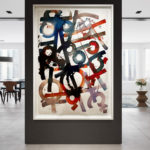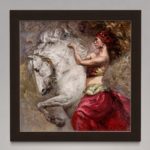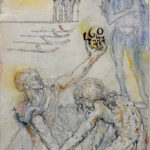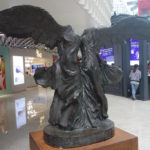 Salvador Dali (Spanish, 1904-1989)
Salvador Dali (Spanish, 1904-1989)
“Alice in Wonderland” (1977-1984)
Blue Patina Edition of 350 with 35EA in bronze.
90.5cm (including base).
Literature: Catalogue Raisonne “Le Dur et le Mou” by Robert & Nicolas Descharnes, pg. 243, Ref #624.
SOLD
 Salvador Dali (Spanish, 1904-1989)
Salvador Dali (Spanish, 1904-1989)
“Space Elephant” (1980)
(Prestige-scale- blue/green/gold patina)
Bronze Ed. Of 350.
37″ (94cm)
Literature: Descharnes, Robert & Nicolas “Le Dur et le Mou” catalogue, pg. 244-245, Ref #631
 Salvador Dali (Spanish, 1904 – 1989)
Salvador Dali (Spanish, 1904 – 1989)
Cosmic Rhinoceros.
Bronze signed and numbered.
Patina : Green Florentine, Pyramid gilded in fine gold leaf patina.
Foundry : Airaindor / Valsuani.
Dimensions: 36,2 in x 25.2 in x 13.4 in
Certificate of authenticity issued by publisher and Airaindor Valsuani Fondeur.
Literature: Catalogue Raisonne “Salvador DALI: Le Dur et le Mou” by Robert and Nicolas Descharnes page 71.
Debris of an Automobile Giving Birth to a Blind Horse Biting a Telephone (1988)
Green glass paste and bronze from DAUM Glassworks of Nancy, France
Hgt: 44.5cm
Edition of 850
Literature: Robert & Nicolas Descharnes, Catalogue Raisonne “Le Dur et Le Mou”, pg. 134, Ref #342
 Salvador Dali (Spanish, 1904-1989)
Salvador Dali (Spanish, 1904-1989)
“Cabinet Anthropomorphic” (1982)
Edition of 330 in bronze.
30cm x 60cm.
Literature: Catalogue Raisonne “Le Dur et le Mou” by Robert & Nicolas Descharnes, pg. 266, Ref #683.
 Salvador Dali (Spanish, 1904-1989)
Salvador Dali (Spanish, 1904-1989)
“Dragon Swan Elephant” (1969)
Prestige Edition of 19 in bronze.
31cm x 47cm x 44cm.
Literature: Catalogue Raisonne “Le Dur et le Mou” by Robert & Nicolas Descharnes, pg. 171, Ref #434-436.
The double image that made Salvador Dali famous during his surrealist period via the “paranoc-critical” method is here surpassed by a triple image. Dali has succeeded in modelling three animals in one single composition.
The swan directly evokes the myth of Leda and the Swan, parents to the hermaphrodites Castor and Pollux and Helen and Clymestra, with whom Dali liked to compare himself and Gala. The elephant is recognized as a symbol for the victorious struggle of chastity against lustfulness and the dragon represents the evil that must be defeated in order to obtain any kind of good, whether it be physical, psychic or spiritual.
Venus de Milo with Drawers (1988)
Pale blue glass paste from DAUM Glassworks of Nancy, France
Hgt: 43cm
Edition of 850
Literature: Robert & Nicolas Descharnes, Catalogue Raisonne “Le Dur et Le Mou”, pg. 134, Ref #339
Salvador Dali (Spanish, 1904-1989)
“Horse Saddled with Time” (1975-1984)
Edition of 350 with 35EA in bronze.
Venturi Fonderia (Cast, c. 1977-1979)
53cm (including base)
Certified by publisher IAR as descended from Dali
Literature: Catalogue Raisonne “Le Dur et le Mou” by Robert & Nicolas Descharnes, pg. 252, Ref #651.
 Salvador Dali (Spanish, 1904-1989)
Salvador Dali (Spanish, 1904-1989)
“Gala Gradiva” (c. 1970)
Edition of 99.
89.5cm (including base).
Literature: Catalogue Raisonne “Le Dur et le Mou” by Robert & Nicolas Descharnes, pg. 170, Ref #430.
A P.E. cast of the 89,5 x 48 x 45 cm edition is part of the permanent collection of the Butler Institute of American Art (Ohio, USA).
After having read Freud’s analysis of W. Jensen’s Gradiva, Dali recognized Gala as his Gradiva and, like Hanold, the main character of Jensen’s story, “He was unable to explain what it was in her that aroused his interest; he only knew that from the first moment he had felt dominated by an intense attraction which time did not succeed in weakening”.
“as she walks, she gathers up her flowing garments, revealing her sandaled feet, one of which rests completely on the ground, whilst with the other she is on tiptoes, the sole and ankle almost perpendicular to the earth. This pose is not at all usual and the artist wished to place it in his sculptural work because of the special attraction it produces.” Sigmund Freud on “Gradiva” by W. Jensen.
Salvador Dali (1904-1989)
“Nude Ascending the Staircase: Homage to Marcel Duchamps” (a.k.a. “Nu Montant L’Escalier”)
(1973)
Prestige-scale Bronze Ed. 2/9 (Fonderia Bonvicini, Verone, Italy)
55cm x 32.5cm x 37.5cm
Literature: Descharnes, Robert & Nicolas “Le Dur et le Mou” catalogue, pg. 162-163, Ref #412
The concept behind this piece is found in Nu Descendant un escalier, numéro 2, a pre-Dadaist piece presented by Marcel Duchamp in the Dalmau Gallery in Barcelona in 1912 at the “First Cubist exhibition” held in Spain.
Nothing could please Dali more, than to pay tribute to his friend Marcel Duchamp by creating the ironic opposite to the famous divisionist painting; hence this beautiful realistic body – which reminds us in the form of Gala, climbing up the spirals in a marine shell, symbol of universal life and eternity. All together, the piece exudes reflection and eroticism.
 Salvador Dali (Spanish, 1904 – 1989)
Salvador Dali (Spanish, 1904 – 1989)
Rhinoceros Habille en Dentelles
Bronze signed and numbered.
Patina : Green Florentine, Sea Urchin gilded in fine gold leaf patina.
Foundry : Airaindor / Valsuani.
Dimensions: 15 in x 22.8 in x 13.6 in
Certificate of authenticity issued by publisher and Airaindor Valsuani Fondeur.
Literature: Catalogue Raisonne “Salvador DALI: Le Dur et le Mou” by Robert and Nicolas Descharnes page 69.
 Salvador Dali (Spanish, 1904-1989)
Salvador Dali (Spanish, 1904-1989)
“Space Venus” (1977-1984)
Edition of 350 with 35EA in bronze.
Venturi Fonderia (Cast, c. 1977-1979)
65cm (including base).
Certified by publisher IAR as descended from Dali
Literature: Catalogue Raisonne “Le Dur et le Mou” by Robert & Nicolas Descharnes, pg. 239, Ref #616.
SALVADOR DALI
“Surrealist Angel” (1983)
Size : 22.5 x 9.5 x 5 in (57.15 x 24.13 x 12.70 cm)
Bronze edition of 1500 examples
Foundry Signature w/Stamp/Chop Mark: Lower left of sculpture
Condition: Excellent
Certificate of Guarantee: Rudolf Rom
Provenance & Extra Info: The sculpture casting was done in collaboration with Salvador Dali and Mr. Rudolf Rom on February 17, 1983. After casting the mold was destroyed. The leather bound Certificate of Authenticity is signed, sealed and notarized.
SOLD
Salvador DALI (1904-1989)
Sun God Rising (prestige-scale) (1974)
Sculpture-Volume , Bronze (Number and/or edition: Edition of 5) , 36x48x74 cm (14.17×18.9×29.13 in) , fantastic , 20th Century Surrealism , Certificate of ownership , Signature , Authentication certificate (2049 Obra Contemporanea) , 431 (Ref: catalogue raisonné)
“Sun God Rising” (1974) Edition number 1 of only 5 PE examples in bronze. 74cm x 48cm x 36cm. Literature: Catalogue Raisonne “Le Dur et le Mou” by Robert & Nicolas Descharnes, pg. 170, Ref #431. Profoundly affected by the horrors of the Second World War, Dali created numerous allegorical works around this theme. Peace after war, life after death. Dali’s faith in humankind is immense. This work is dedicated to all the men that found death in this paradisiacal island, scene of gory battles during World War II.
This mermaid-like being represents all the divine that there is within man. This young long-haired god, rising from the ocean depths, represents the human being who, like the sun, is reborn every day in an infinite renewing cycle of Life. One example featured at DALI Real Circulo Artistico de Barcelona
Terpsichore, Muse of Dance (also known as “Woman in Skirts”)
Prestige-scale Bronze edition of 199
69.5x38x9.5 cm (27.4 x 15.0 x 3.7 in)
Our Muse of Music and Dance seems to be about to take off; we can say that she almost levitates. She was intentionally conceived headless in order to show that she didn’t need of a facial expression or ritual mask in order to show her true self – she is the sacred myth of Victory, celebrated in the dance. We don’t need to see her body, the line’s tension, the volume’s play and the careful texture of the bronze in enough to transmit her whole spirit, that of celebration, triumphant after the Victory.
The sculpture presents some physical similarity to the “Victory of Samothrace” (c. 190) today at the Louvre Museum in Paris.
Salvador Dali (Spanish, 1904-1989)
“Winged Triton” (c. 1972)
Edition of 199.
78cm x 77cm x 43cm (including base).
Literature: Catalogue Raisonne “Le Dur et le Mou” by Robert & Nicolas Descharnes, pg. 164-165, Ref #413.
P.E. casts of the 78 x 77 x 43 cm edition are part of the permanent collections of the Spurlock Museum (Illinois, USA) and of the Memorial Art Gallery (New York, USA).
In mythology, charitable half-god who comes from the depths of the sea, on occasions he is also bloodthirsty. According to the legend, Triton used to appear above the waters to calm the waves and lull the storms.
Did Triton ever emerge from the deep waters at Cape Creus? Did Dali ever see him all powerful conquering the forces of nature? This thought comes to our mind when we see how many drawings are conserved in which the painter, with raised hand, drew various silhouettes of Neptune’s son.
CONTACT:
Reed V. Horth
ROBIN RILE FINE ART
Miami, FL USA
PH: (813) 340-9629
Skype: reed.v.horth
LinkedIn: www.linkedin/in/rvhorth
Facebook: www.facebook.com/robinrile













